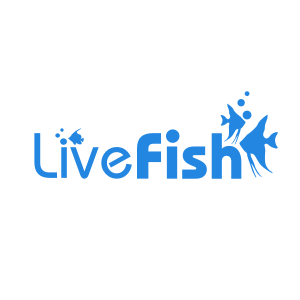Blunthead Wrasse - Medium
The Blunthead Wrasse is an attractive multi-coloured species with a distinctive head shape. It is an active swimmer and will liven up any aquarium.
Blunthead Wrasse
The Blunthead Wrasse stands out because of its round or blunt head shape. Its color varies, depending on age and gender. The transformation from juvenile to adult male is spectacular. Juveniles and females have a similar appearance. They have whiteish bodies, with dark bands along the middle and top of their body. Both also have an orange mark next to their tailfin. Male adults have a green head with a band of yellow behind it. The rear of the body is a textured blue/red color, with red dorsal and tailfin.
Terminal males and females can be identified by their color difference. But the initial stage males and females look remarkably similar. This species is hermaphroditic. The largest female will change sex and take on the role of the male when required. Unusually, it is behavioral changes in smaller conspecifics that trigger this. Spawning can either occur in a group or, more commonly, as a pair. Courtship involves a "looping" dance, with the male performing in front of the female. Then they swim to the surface to spawn before returning to the reef. There are no records of Blunthead Wrasse breeding in captivity,
The Blunthead Wrasse is found in the Indian and Pacific Oceans. Locations include The Maldives, Indonesia, Japan, and Australia. Their usual habitat is in lagoons and on coral reefs, between depths of 1-15 meters.
Tank Recommendations for your Blunthead Wrasse
The Blunthead Wrasse needs a tank that is at least 75 gallons (283.9 liters).
They will need monitoring if introduced to a reef environment as they will eat small inverts. The most suitable option is a Fish Only With Live Rock (FOWLR) tank.
A sand substrate is advisable as it will burrow into it if scared or sometimes to sleep at night. Blunt head Wrasses also need rockwork with plenty of caves and hiding places. This species is active in the water and requires open space for swimming. There should also be a secure lid on the tank to prevent jumping.
Suitable Tank Buddies
The Blunthead Wrasse is semi-aggressive. It is possible for juvenile and initial phase Blunthead Wrasse to co-habit. Adults are best kept as the only species member in a FOWLR tank. If attempting to house a male/female pair the tank should be at least 125 gallons (473.2 liters).
It is preferable to house Blunthead Wrasse with larger, boisterous tank buddies.
Usually Compatible
Suitable tankmates include Boxfish, Large Angelfish, Damselfish, Clownfish, and Tangs/Surgeons,
Sometime Compatible
Caution is advised with Dwarf Angelfish, Anthias, Blennies, Gobies, Chromis, Hogfish, and Triggerfish.
Rarely Compatible
Blunthhead Wrasse will hunt for small invertebrates on the tank bed. Avoid Seahorses or Pipefish as a Blunthead Wrasse will be too quick and aggressive.
Feeding your Blunthead Wrasse
Blunt head Wrasses are carnivorous. They will consume a wide range of meaty products. Their diet should contain vitamin enriched Brine and Mysis Shrimp, Krill, and Squid. They can also eat crustaceans, flake foods, and pellets. Feeding should occur 3 times per day.
| Scientific Name | Thalassoma amblycephalum |
|---|---|
| Care Level | Moderate |
| Common Names | Blunthead Wrasse, Rainbow Wrasse and Twotone Wrasse. |
| Diet | Carnivore |
| Fish Family | Labridae |
| Lifespan (years) | 10 |
| Max. Length (cm) | 15 |
| Min. Tank Volume (l) | 284 |
| Origin | Indian and Pacific Oceans. Locations include The Maldives, Indonesia, Japan, and Australia |
| Reef Safe | With Caution |
| Sociability | Semi-aggressive |
| Venomous | No |
| Water Conditions | 22-25° C, dKH 8-12, pH 8.1-8.4, sg 1.020-1.025 |

